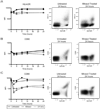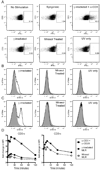Understanding loss of donor white blood cell immunogenicity after pathogen reduction: mechanisms of action in ultraviolet illumination and riboflavin treatment
- PMID: 19682337
- PMCID: PMC2865145
- DOI: 10.1111/j.1537-2995.2009.02333.x
Understanding loss of donor white blood cell immunogenicity after pathogen reduction: mechanisms of action in ultraviolet illumination and riboflavin treatment
Abstract
Background: Donor white blood cells (WBCs) present in transfusion products can lead to immune sequelae such as production of HLA antibodies or graft-versus-host disease in susceptible transfusion recipients. Eliminating the immunogenicity of blood products may prove to be of clinical benefit, particularly in patients requiring multiple transfusions in whom allosensitization is common. This study examines a method of pathogen reduction based on ultraviolet light illumination in the presence of riboflavin. In addition to pathogens, WBCs treated with this system are affected and fail to stimulate proliferation of allogeneic peripheral blood mononuclear cells (PBMNCs) in vitro.
Study design and methods: This study sought to determine the mechanisms regulating this loss of immunogenicity. Treated cells were examined for surface expression of a number of molecules involved in activation and adhesion, viability, cell-cell conjugation, and ability to stimulate immune responses in allogeneic PBMNCs.
Results: Compared with untreated controls, ultraviolet (UV)-irradiated antigen-presenting cells showed slightly reduced surface expression of HLA Class II and costimulatory molecules and had more significant reductions in surface expression of a number of adhesion molecules. Furthermore, treated cells had a severe defect in cell-cell conjugation. The observed loss of immunogenicity was nearly complete, with UV-irradiated cells stimulating barely measurable interferon-gamma production and no detectable STAT-3, STAT-5, or CD3-epsilon phosphorylation in allospecific primed T cells.
Conclusion: These results suggest that defective cell-cell adhesion prevents UV-irradiated cells from inducing T-cell activation.
Conflict of interest statement
Conflict of Interest: Rachael P. Jackman and John W. Heitman have no conflict of interest. Susanne Marschner and Raymond P. Goodrich are employed by CaridianBCT Biotechnologies, Philip J. Norris has a consulting relationship with and received research funding for this project from CaridianBCT Biotechnologies.
Figures






Similar articles
-
Pathogen reduction with riboflavin and ultraviolet light induces a quasi-apoptotic state in blood leukocytes.Transfusion. 2019 Nov;59(11):3501-3510. doi: 10.1111/trf.15516. Epub 2019 Oct 10. Transfusion. 2019. PMID: 31599981 Free PMC article.
-
Riboflavin-ultraviolet light pathogen reduction treatment does not impact the immunogenicity of murine red blood cells.Transfusion. 2016 Apr;56(4):863-72. doi: 10.1111/trf.13432. Epub 2015 Dec 8. Transfusion. 2016. PMID: 26643781
-
Development of a riboflavin and ultraviolet light-based device to treat whole blood.Transfusion. 2013 Jan;53 Suppl 1:131S-136S. doi: 10.1111/trf.12047. Transfusion. 2013. PMID: 23301965
-
White blood cell inactivation after treatment with riboflavin and ultraviolet light.Transfusion. 2010 Nov;50(11):2489-98. doi: 10.1111/j.1537-2995.2010.02714.x. Transfusion. 2010. PMID: 20529002 Review.
-
Pathogen-reduction systems for blood components: the current position and future trends.Transfus Apher Sci. 2006 Dec;35(3):189-96. doi: 10.1016/j.transci.2006.10.002. Epub 2006 Nov 15. Transfus Apher Sci. 2006. PMID: 17110168 Review.
Cited by
-
Allogeneic major histocompatibility complex antigens are necessary and sufficient for partial tolerance induced by transfusion of pathogen reduced platelets in mice.Vox Sang. 2019 Apr;114(3):207-215. doi: 10.1111/vox.12756. Epub 2019 Feb 7. Vox Sang. 2019. PMID: 30734299 Free PMC article.
-
Pathogen Reduction Technology Treatment of Platelets, Plasma and Whole Blood Using Riboflavin and UV Light.Transfus Med Hemother. 2011;38(1):8-18. doi: 10.1159/000324160. Epub 2011 Jan 31. Transfus Med Hemother. 2011. PMID: 21779202 Free PMC article.
-
Pathogen reduction with riboflavin and ultraviolet light induces a quasi-apoptotic state in blood leukocytes.Transfusion. 2019 Nov;59(11):3501-3510. doi: 10.1111/trf.15516. Epub 2019 Oct 10. Transfusion. 2019. PMID: 31599981 Free PMC article.
-
Chemical and biological mechanisms of pathogen reduction technologies.Photochem Photobiol. 2014 Sep-Oct;90(5):957-64. doi: 10.1111/php.12311. Epub 2014 Aug 20. Photochem Photobiol. 2014. PMID: 25041351 Free PMC article. Review.
-
Polyinosinic: polycytidylic acid induced inflammation enhances while lipopolysaccharide diminishes alloimmunity to platelet transfusion in mice.Front Immunol. 2023 Dec 11;14:1281130. doi: 10.3389/fimmu.2023.1281130. eCollection 2023. Front Immunol. 2023. PMID: 38146372 Free PMC article.
References
-
- Goodrich RP, Edrich RA, Li J, Seghatchian J. The Mirasol PRT system for pathogen reduction of platelets and plasma: an overview of current status and future trends. Transfus Apher Sci. 2006;35:5–17. - PubMed
-
- Cardo LJ, Rentas FJ, Ketchum L, Salata J, Harman R, Melvin W, Weina PJ, Mendez J, Reddy H, Goodrich R. Pathogen inactivation of Leishmania donovani infantum in plasma and platelet concentrates using riboflavin and ultraviolet light. Vox Sang. 2006;90:85–91. - PubMed
-
- Cardo LJ, Salata J, Mendez J, Reddy H, Goodrich R. Pathogen inactivation of Trypanosoma cruzi in plasma and platelet concentrates using riboflavin and ultraviolet light. Transfus Apher Sci. 2007;37:131–137. - PubMed
-
- Rentas F, Harman R, Gomez C, Salata J, Childs J, Silva T, Lippert L, Montgomery J, Richards A, Chan C, Jiang J, Reddy H, Li J, Goodrich R. Inactivation of Orientia tsutsugamushi in red blood cells, plasma, and platelets with riboflavin and light, as demonstrated in an animal model. Transfusion. 2007;47:240–247. - PubMed
-
- Fast LD, Dileone G, Li J, Goodrich R. Functional inactivation of white blood cells by Mirasol treatment. Transfusion. 2006;46:642–648. - PubMed
Publication types
MeSH terms
Substances
Grants and funding
LinkOut - more resources
Full Text Sources
Medical
Research Materials
Miscellaneous

